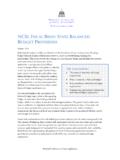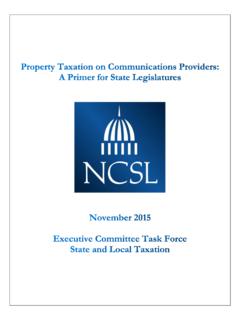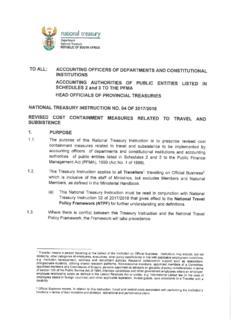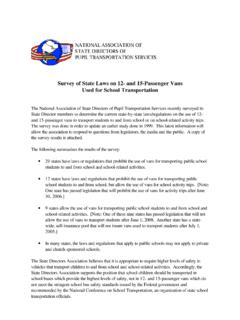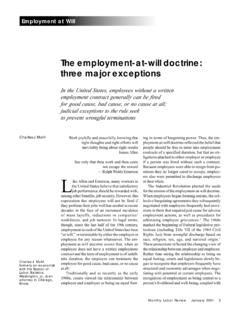Transcription of September 30, 2015 U.S. Department of the …
1 September 30, 2015 Laura Temel Attn: Marketplace Lending RFI Department of the Treasury 1500 Pennsylvania Avenue NW. Room 1325 Washington, DC 20220 Dear Ms. Temel, The Conference of State Bank Supervisors ( CSBS )1 and the National Association of Consumer Credit Administrators ( NACCA )2 are pleased to comment on the Department of the Treasury s notice and request for information on Expanding Access to Credit through Online Marketplace Lending, Billing Code 4810-25-P ( RFI ). CSBS and NACCA commend Treasury s effort to collect information on a new form of lending that has the potential to expand credit availability in the United States but that also raises important questions about regulation and borrower protection.
2 As state regulatory associations, CSBS and NACCA will focus on questions related to the financial regulatory framework. State regulators are stewards of the credit markets in their states, licensing and overseeing a broad and diverse set of financial services institutions. This authority derives from state and federal law and reflects decisions made in state legislatures and in Congress about the structure of the financial marketplace and about the role of state regulators in the larger regulatory fabric. In carrying out these responsibilities, our members evaluate an institution s ability to operate safely and soundly and to serve borrowers responsibly and effectively. As state regulators, we 1 CSBS is the nationwide organization comprised of banking regulators from all 50 states, the District of Columbia, Guam, Puerto Rico, and the Virgin Islands.
3 State banking regulators supervise nearly 5,200 state-chartered financial institutions. Further, most state banking departments also regulate a variety of non-bank financial services providers. 2 Formed in 1935, the National Association of Consumer Credit Administrators (NACCA) consists of regulatory agencies from 49 states, the District of Columbia, Puerto Rico, and Alberta, Canada that license and regulate non-depository institutions such as finance companies, mortgage companies, small loan companies, pay day lenders, pawnbrokers, and other similar types of industries. 2 have an on-the-ground perspective on innovation s benefits and opportunities and on the need for a stable and well-regulated financial marketplace. In what ways should policymakers be thinking about market segmentation; and in what ways do different models raise different policy or regulatory concerns?
4 As noted in the RFI, marketplace lenders have four general business models: Balance Sheet Lenders originate loans and retain credit risk in their own portfolios; Online Platforms (peer-to-peer) pass-through securitization structure where loans are immediately sold to investors, who retain the credit risk; Bank-Affiliated banks originate and hold, distribute, and/or return loans to the marketplace lender; and Bank-Partnerships loans are funded by a bank and sold to an investor or to the marketplace lender. Applicable state laws will differ by business model and whether products are consumer or commercial in nature. Balance Sheet Lenders Balance sheet consumer lenders are subject to state consumer finance laws. Given the position of trust and confidence held by consumer lenders and their critical function within local economies, state law generally requires the licensing of companies and individuals that extend loans to consumers as a business.
5 While all states regulate consumer lenders through a comprehensive system of licensure and supervision, the majority of states do not license and supervise commercial lenders. Commercial lenders are instead regulated under general securities and contract laws. In addition, many states license entities that solicit or broker loans, even if the loans will eventually be closed in the name of a bank or other authorized lender. Online Platform (peer-to-peer) Peer-to-peer lenders are similar to balance sheet lenders in that under both business models, the marketplace lender holds itself out to consumers, controls the underwriting criteria, sets the interest rates and credit terms, and originates the loans. These companies do not partner with banks.
6 The difference is that peer-to-peer lenders use an originate-to-distribute model where loans are matched to investors. Investors provide funding for the loans, which are originated by the marketplace lender and subsequently held and serviced by the marketplace lender on behalf of the investor. 3 Direct interaction with consumers and the moral hazards associated with originate-to-distribute models are two policy areas that typically warrant regulation. Accordingly, policymakers should investigate whether a regulatory regime is advisable. CSBS and NACCA commit to working with Treasury to discuss state consumer credit laws, their applicability to different business models, and how these laws can be deployed in a manner that fosters innovation. Bank-Affiliated Lenders Bank affiliated lenders are essentially third-party service providers for banks seeking to deploy a new means of originating smaller consumer and business loans.
7 By utilizing software to effectuate a bank s credit policies, some banks are looking to bank-affiliated marketplace lenders to originate credit in circumstances where it might otherwise be cost prohibitive. State and federal laws governing the use of third-party service providers are applicable, as discussed below. Bank Partnerships Some marketplace lenders form relationships with commercial banks whereby the bank originates the loans on behalf of the marketplace lender. The loan is then sold to the marketplace lender who can either hold the loan in portfolio or sell it to investors. This business model is not unique to marketplace lenders and has been used by payday lenders attempting to bypass state licensure and usury laws by arguing that the loan is technically closed in the bank s While this RFI specifically excludes short term/high-cost lenders, other types of consumer lenders have already litigated the issue of who the true lender is in these arrangements.
8 Prior case law related to short term/high-cost lenders is relevant because the underlying legal question is whether lenders can partner with a bank to bypass state licensure laws. When addressed in the context of short term/high-cost lenders, the details of the product loan duration and interest rate were inconsequential for determining the true lender. 4 There are a number of ways to define the true lender, including focusing on the party who closes the loan, the party setting the credit terms and disbursing funds, or the entity with predominant economic interest. Case law on the subject thus far is mixed; a number of federal 3 Under, the Depository Institutions Deregulation and Monetary Control Act of 1980, state-chartered banks may charge loan interest at rates not exceeding the higher of (i) the maximum rate allowed by the state in which the loan is made, and (ii) the maximum rate allowed by the bank s home state.
9 The National Bank Act contains an analogous provision for national banks. 12 85. Payday lenders have attempted to partner with banks to take advantage of these favorable laws. 4 Cf. FDIC v. Lattimore Land Corp., 656 139, 147-49 (5th Cir. Unit B 1981). 4 and state courts have reached different conclusions by focusing on either the substance or the form of the Treasury will need to be aware of the true lender tests and potentially speak to this issue in any policy recommendations. Describe whether and how marketplace lending relies on services or relationships provided by traditional lending institutions or insured depository institutions. What steps have been taken toward regulatory compliance with the new lending model by the various industry participants throughout the lending process?
10 What issues are raised with online marketplace lending across state lines? Supervision of Banks Involved in Marketplace Lending Both national banks and state chartered banks have long been able to partner with third parties to provide various consumer credit and deposit products. Banks originating loans for such third parties are expected to operate with comprehensive controls designed to protect the consumer from harm, and to protect the bank from any undue risk associated with third-party partnerships (namely, operational risk, legal risk, reputational risk). Banks so involved should have particularly robust compliance management systems and vendor oversight programs. Banks should also expect their partners to have developed rigorous compliance management systems and should have contractual rights to audit those programs.

